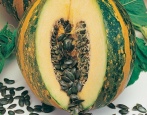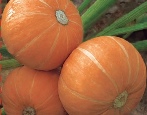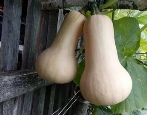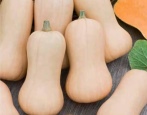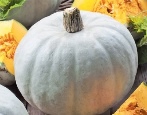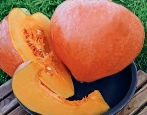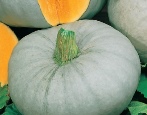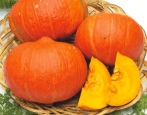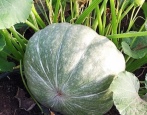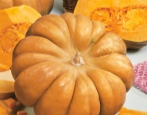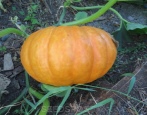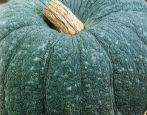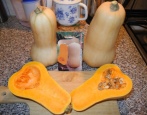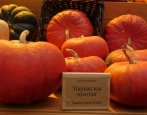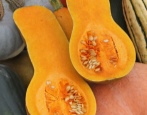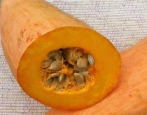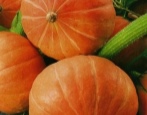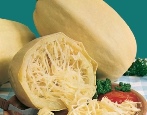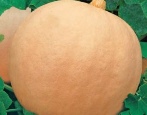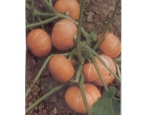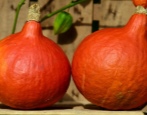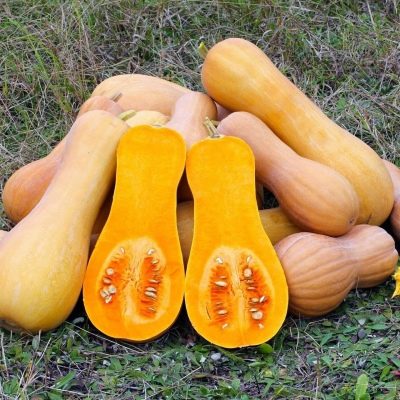
- Authors: Tekhanovich G.A.
- Year of approval: 2000
- Growth type: powerful
- Leaf shape: pentagonal, unbroken
- Leaf color: dark green, with a slight white spot
- The form: cylindrical
- Weight, kg: 2.6-5.6 (according to the originator, up to 7.5)
- Coloration: background color is orange, sometimes with a bluish bloom, pattern in the form of spots of orange color and fine mesh
- Bark: thin, bendable
- Color of the pulp: dark orange
Sweet butternut pumpkins have long been grown by gardeners. Pearl is among the top ten varieties of such pumpkins. The peculiarities of the plant should be known to everyone who is fond of cultivating such specimens.
Description of the variety
Pearl pumpkin was bred and developed by the domestic breeder G.A.Tehanovich.It has been in the State Register since 2000. Mid-late pumpkin produces excellent yields of cylindrical fruits that are easy to store. The plant resists drought and cold well, and the fruits are easily transported without losing their attractive appearance. And yet there are also many disadvantages. Such a pumpkin requires good care, good quality soil. It can be affected by diseases, pests. Shelf life is three months, and towards the end of this period, the fruits begin to lose their taste characteristics.
Characteristics of the appearance of plants and fruits
Pearl is a climbing and powerful plant. It can stretch by 70-100 centimeters, it has several strong lateral shoots. All shoots form single ovaries. The foliage is pentagonal, does not differ in dissection. Dark green plates are dotted with small white specks. And also the surface of the leaves is covered with a weakly expressed fluff.
Let's move on to the description of the Pearl fruits:
pumpkins have a cylindrical shape, like a squash;
the tip has a thickening in the form of an oval or circle, it contains a small seed nest;
pumpkin seeds are broadly oval and smoky cream, their amount is 0.3%;
the surface of pumpkins is usually smooth, in rare cases it can be slightly segmented;
fruit length - 40-55 centimeters, weight - 2.6-5.6, sometimes up to 7.5 kg;
the color of the peel is orange, sometimes there is a bloom of a bluish tint;
the pulp has a dark orange color, it is very juicy, crunchy;
fruits contain an increased amount of carotene - 14.1 mg per 100 grams of pulp.
Purpose and taste
Pearl has a very delicate taste and light pumpkin aroma. She is incredibly sweet, pleasant, juicy. Pumpkin can be used in many different areas of cooking. Soups and cereals, various side dishes are prepared from it, and added to stews. In addition, many people bake such pumpkin with cinnamon, prepare candied fruits, juices, and soft drinks from it. Pearl is widely demanded in the children's diet. It can also be preserved, frozen.
Ripening terms
The ripening time of Pearl is characterized as medium. Usually it is 120-130 days. From July to September, you can pick fruits. At the same time, pumpkin tails do not break off to the end, and the fruits themselves stand up to 4 days in the sun.
Yield
The high popularity of Pearl is due to its abundant harvests. In compliance with the rules of agricultural technology, you can count on 15 kg per square meter. On average, 172-449 centners are harvested per hectare. In this case, it is worth considering the capriciousness of the culture. In warm regions and on fertile soil, it gives maximum yields.
Growing regions
Pumpkins of this variety are mainly distributed in the North Caucasian, Ural and Far Eastern regions.
Growing and care
In April, pearl seeds are sown for seedlings.Before that, it is recommended to treat them with manganese and fungicides. In May or early June, ready-made sprouts are planted in holes according to the scheme 60x60 centimeters. And you can also plant seeds directly into the ground, this method is adopted in the southern regions. As with the seedling technique, the grains are processed. They are planted at the same time as seedlings.
Next, you must follow the rules of agricultural technology developed for this variety.
Watering. Irrigation must be timely, Pearl is very fond of water, although it is a drought-resistant subspecies. The liquid temperature should be at least 20 degrees. Watering is at the rate of 5 liters per plant. Particular attention is paid to irrigation during flowering and fruit setting. When they begin to actively form, the amount of watering is reduced.
Loosening. This procedure is carried out even before watering, gently plowing up the soil by 10 centimeters. Loosening can be combined with weeding.
Fertilizers. Pearl should be fed several times per season. 14 days after germination, the plants are given a mullein solution in a ratio of 1: 10. A bucket is enough for 5 bushes. After the 5th leaf, 2 tablespoons of nitrophosphate are placed under each bush, mixed with earth. At the time of the formation of lashes, a tablespoon of nitrophosphate is stirred in a bucket of water. Each plant will require 1 bucket. And also once a month you need to dust the pumpkin with wood ash, or pour it with a solution from it.
Important: with the start of branching shoots, it is recommended to moisten the ground and sprinkle internodes with it. So the plant will receive nutrients more actively. Sprinkle at least 2 times during the growing season.
Requirements for soil and climatic conditions
Pumpkins love warmth very much, this applies to absolutely all varieties. Pearl is no exception. It should be planted on a warm day. The minimum permissible temperature is 13 degrees, but the active development of the culture begins only at 18-25 degrees. The place of growth should be as sunny as possible, partial shade and shade will prevent the appearance of the ovary. To maintain the temperature for the first time, pumpkin beds can be covered with foil.
The plant prefers fertile soil. It should be abundantly fertilized with organic matter and minerals in the fall. Acidic and alkaline substrates are prohibited. Places where pumpkins, cucumbers, zucchini were previously grown should also be avoided. In general, black soil would be a good solution, but loamy, sandy loam soils are also suitable. Experienced gardeners plant pumpkins on dung or compost heaps, growing real giants. Fresh organic matter absolutely does not harm the root system of the culture.
Disease and pest resistance
Nutmeg is susceptible to disease. She suffers from powdery mildew, root rot, and other fungal diseases. Cases of fusarium wilting are not uncommon. Problems can be easily avoided if the seeds are treated with fungicides even before planting. And also it is worth following all the rules of care. It is very important not to allow heavy fruits to come into contact with the soil. You need to put cardboard or other dense material.
Pearl can be attacked by melon aphids, and spider mites often start on it. Strong roots love to gnaw on bears. Aphids and ticks in the early stages are destroyed by various folk remedies, for example, a solution of ash, laundry soap. If there are a lot of bears, it is better to use chemicals.
Review overview
Pearl is often found in reviews of butternut squash. The variety is loved for its sweet taste and aroma, easy storage. Many people argue that pumpkins of this shape are very easy to clean. You can remove the fruits at the stage of incomplete ripeness, they ripen perfectly at home.
Nevertheless, you should be careful when buying seeds even from well-known producers.Some gardeners bought Pearl, and received ordinary round pumpkins, which, moreover, germinated extremely poorly. However, such cases are rare.
